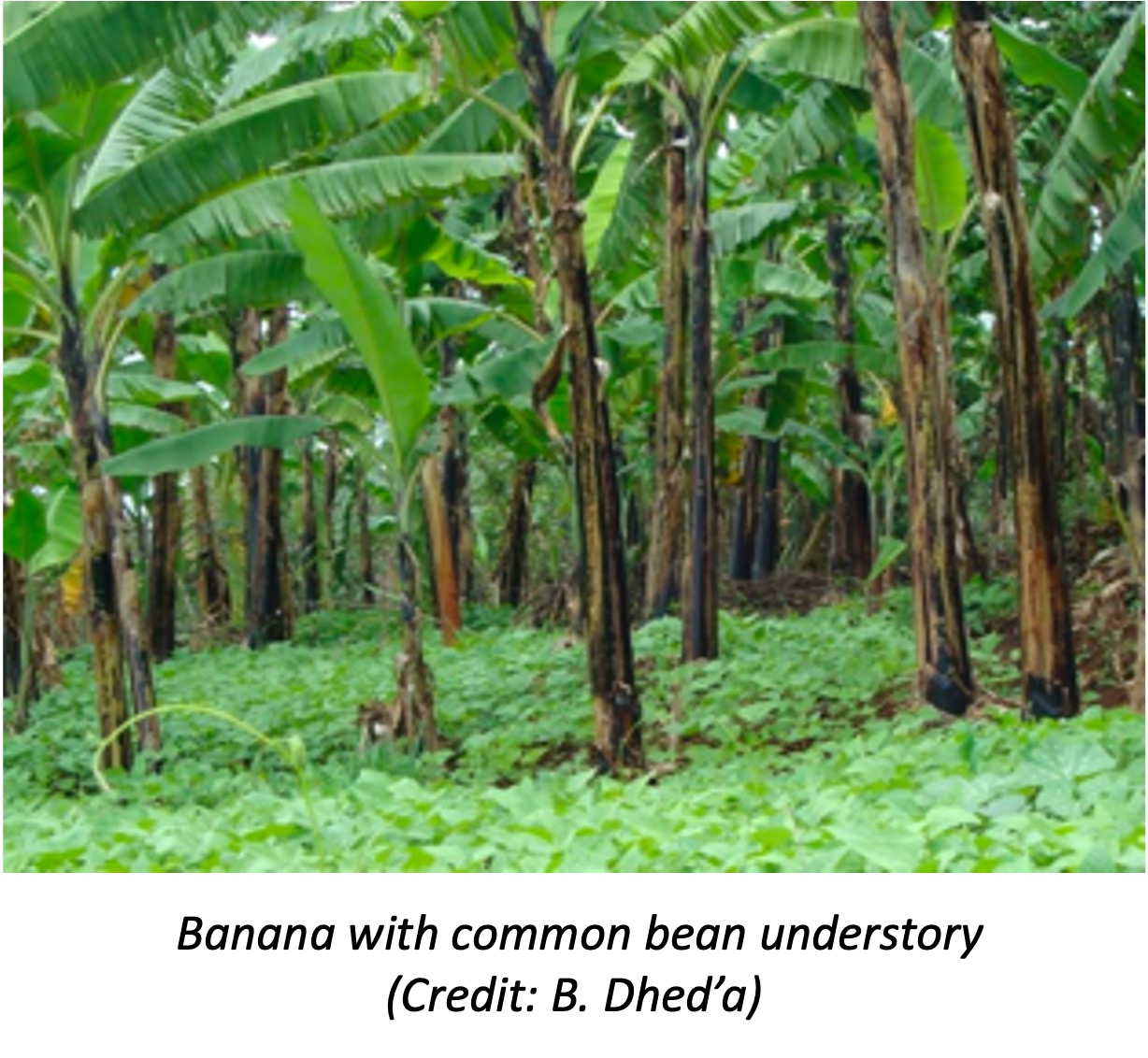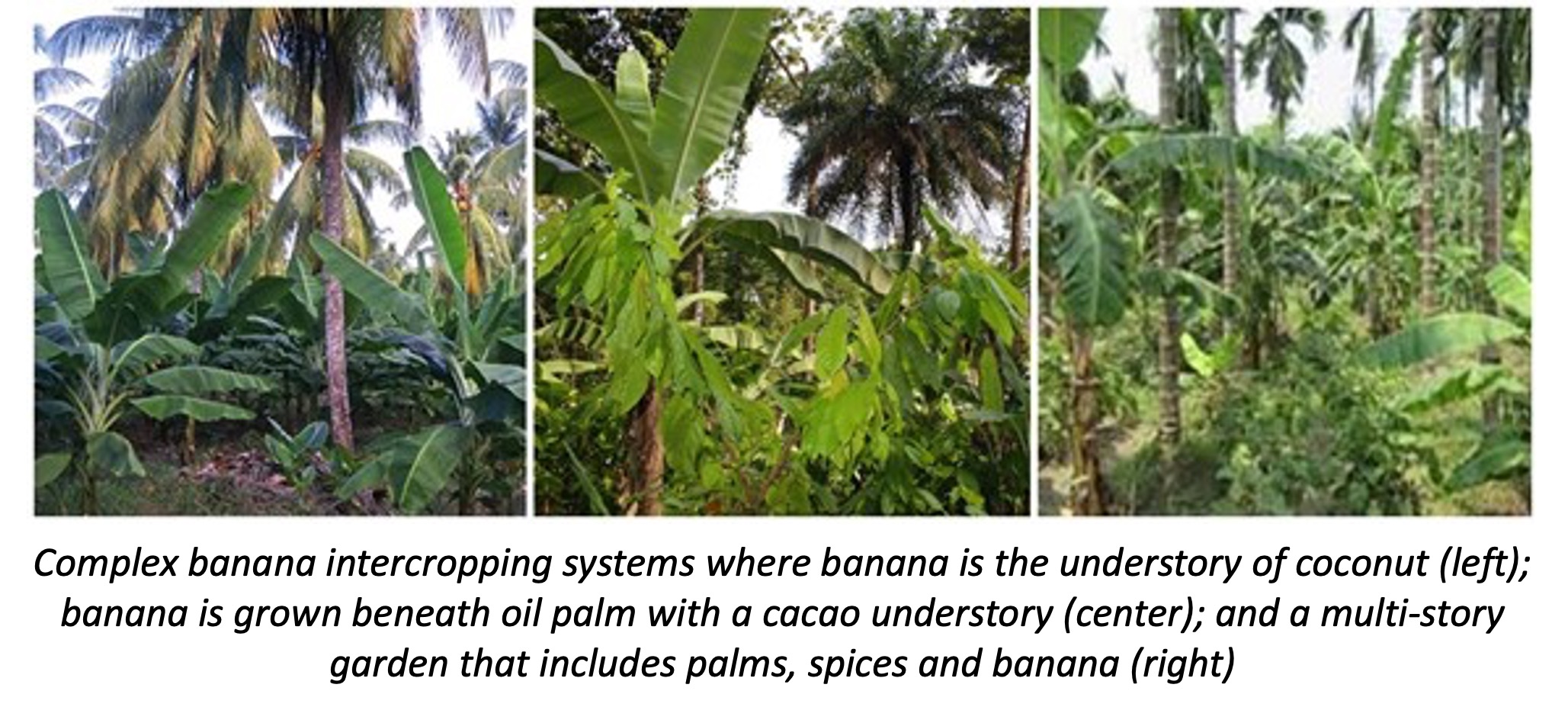Intercropping Strategies for Banana and Plantain
Résumé
There are several advantages and disadvantages from intercropping bananas or plantains with other crops. Intercropping with annual field crops allows for early harvests months before banana yields, and in the process suppress weeds within the plantation. Intercrop canopies and roots protected against soil erosion. Legume intercrops provide nitrogen through biological fixation. Biomass from the intercrops may be applied as mulches and sources of organic nutrients. The disadvantages of intercropping include below- and aboveground competition for nutrients and water, the potential introduction and spread of diseases, and damage to banana roots from soil disturbance during planting and harvest of companion crops. A common practice is to intercrop with annuals during the first year of plantation establishment; another is to grow bananas with shade tolerant perennial crops such as coffee or cacao. A third option is to grow bananas with agroforestry trees that provide poles that support banana stalks and fruit.
En savoir plus sur la solution
Intercropping involves the production of two or more crops simultaneously on the same land. It serves as insurance against crop failure due to abnormal weather conditions. In the case of banana and plantain, it is possible to establish a multi-story system where crops with different canopy heights are established. Intercropping of bananas with other crops is common soil fertility improvement practice. Trees such as mangos and papaya may be established within banana plantations as sources of fruit and to serve as windbreaks. Root systems of banana and plantain are delicate and require fertile soil to allow sufficient water and nutrient uptake and guarantee anchorage and sucker production. The residues of companion crops may provide this need. Understory intercropping makes it possible to achieve a high level of land, nutrient and water use efficiency due to synergistic effects between the two different crops. Mixing of crops also reduces the infestation rate of weeds, pests and diseases on farmer fields which benefits the productivity of both and slows down the spread of organisms that are harmful to agriculture. Inorganic fertilizers are used very efficiently in mixed cropping systems greater diversity in root structure results in greater capture. One difficulty with intercropping however is that some field operations become more complicated, confounding mechanization and herbicide application.
Integration of other crops is suitable for all banana and plantain growing areas in Sub-Saharan Africa, and is particularly advantageous under low soil fertility and moisture availability. Intercropping legumes contributes to strengthening the climate resilience of food systems and the communities that draw income from them. Understories of younger plantations may be intercropped with food crops such as groundnut, sweet potato or bush bean. Choice of the understory depends agro-ecological conditions, marketing opportunity, and food preferences. Maize intercrops are often considered harmful because of competition. It is best that young plantations be intercropped with plants that cover the soil quickly to protect soils. Older plantations with more complete canopies benefit from shade tolerant intercrops.
The type of crop grown in the understory of banana or plantain stands can be chosen by farmers in line with agro-ecological conditions, marketing opportunity, production needs, and eating habits. Improved varieties of both crops that are well adapted to specific conditions in growing areas should be used to achieve maximal benefits. Bananas and plantains must be intercropped with crops that cover the soil very quickly and for a long time until the foliage protect the soils. Legumes and cocoyam offer these advantages and provide fast income to the farmer faster. The most common intercropping practices across the Ituri and North-Kivu provinces of DR Congo are banana-bean, banana-bean-taro, banana-maize-bean and banana-coffee intercrops, whereas plantain-maize, plantain-maize-rice, plantain-maize-casava, plantain-casava, plantain-casava-rice and plantain-rice, in Tshopo Province.
For intercropping, the two crops can be planted simultaneously or in relay, so their growth and harvest are aligned with farmer conditions and needs. Different layouts can be used with the associated crops planted on alternating rows, in strips of 2-3 rows or randomly positioned. Common bean should be inoculated with an elite strain of N-fixing microorganisms to maximize biological N fixation and in some cases, this must be complemented with N fertilizer application at the right time and placement to improve soil fertility status. Access to seed of improved varieties as well as together with careful extension on the use of inoculants.
Commercialisation
Disponible dans le commerce
Images de la Solution
Institutions




